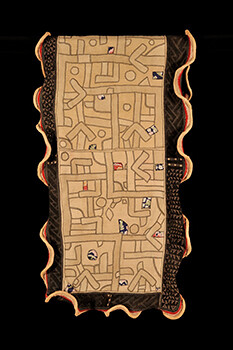March 1–June 14, 2015
Opening: March 1
Neuberger Museum of Art
735 Anderson Hill Road
Purchase, New York 10577
T +1 914 251 6100
www.neuberger.org
The Kuba skirts and overskirts worn by men and women on special occasions such as festivals and funerals are among the most extraordinary of African textiles. Woven by men and embellished by women in the Kuba region in present-day Democratic Republic of the Congo, they are decorated with patterns and motifs that are bold and intricate, irregular and ordered. Notable not only for their beauty but also for their scale, “some garments reach nearly thirty feet in length,” notes Marie-Thérèse Brincard, curator of Kuba Textiles: Geometry in Form, Space, and Time, a historic exhibition, organized by the Neuberger Museum of Art, Purchase College, SUNY. Worn wrapped around and around the body several times, the textiles are distinctive and spectacular. The exhibition will be on view from March 1 through June 14.
Kuba Textiles provides the rare opportunity to see, for the first time, works from two of the earliest collections of textiles from the Kuba region: the Musée Royal de l’Afrique Centrale, Tervuren, Belgium, and the Sheppard Collection at Hampton University in Virginia. Included in the exhibition are 41 skirts and overskirts and 41 objects, many dating from just before and after the turn of the 20th century. Considered in their historical context and displayed publicly in this exhibition for the very first time, Kuba Textiles provides ambitious new scholarship on one of Africa’s most important artistic forms.
“For a long time, the study of African art emphasized sculpture, considered by Western collectors to be Africa’s major art form,” writes Ms. Brincard in the fully illustrated, 140-page catalogue that accompanies the exhibition. “Textiles, pottery, decorative arts, and furniture, which are of equal cultural importance in African societies, were for a long time neglected or ignored.” Kuba Textiles fundamentally changes that approach to the arts of Africa. “[The] cloth [is] made in looms of native construction, soaked and pounded, soft as linen…”—an observation by the African-American Presbyterian missionary, William Henry Sheppard, the first Westerner to be received by the reigning Kuba king, Kot a Mbweeky II, in 1892.
The creation of these skirts and overskirts is a complex and lengthy process, which includes weaving, dyeing, and embellishing with embroidery, appliqué, patchwork, and additional dye. It can take a month of steady work for one small square of a Kuba textile to be completed. Designs are generated from more than 200 traditional patterns.
“The workmanship and patterning are simply exquisite,” notes Ms. Brincard, who points out that Kuba textiles have influenced 20th-century Western art, most notably in details of paintings by Gustav Klimt, as well as in stage design, a form highlighted in the exhibition through the inclusion of an imposing costume made from actual Kuba cloth by the great German set designer, Jürgen Rose, for the character of King Marke in Wagner’s Tristan und Isolde. This remarkable garment, on loan from New York City’s Metropolitan Opera, speaks to the creativity of the Kuba peoples and exemplifies the influence of their design on generations of artists.
Generous support for Kuba Textiles: Geometry in Form, Space, and Time has been provided by the Coby Foundation, Ltdl the National Endowment for the Arts; the New York State Council on the Arts; Arts Westchester, with support from Westchester County Government; and Elisabeth and Bob Wilmers. Additional support has been provided by members of the African Arts Council of the Neuberger Museum of Art, and the Purchase College Foundation.
*Kuba peoples, Bushoong group, Nsheng, Democratic Republic of the Congo; Woman’s overskirt (ncák minen’ishushuna), late 19th–early 20th century. Raffia, printed cotton cloth, wool, appliqué, embroidery with cut-pile (borders); 66 x 171 x 10 cm. Musée Royal de l’Afrique Centrale, Tervuren, EO.0.0.27401. Gift of Nyim Lukengo’s wife to Marcel van den Abeele, before 1924.

